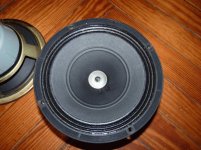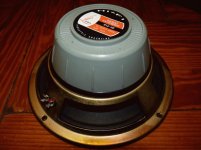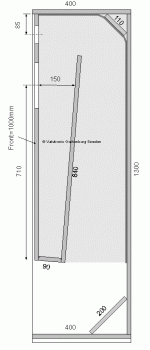Hi,
For sentimental reasons, and just for fun, I want to use a pair of ancient full range drivers, that someone give me for very little money...
I haven't yet measured these, but I suspect this 8 " inchers to have a 60/70 Hz free air resonance and Qts around 0.8 / 1.0.
Will be possible to mount them in a BLH type enclosure, in order of avoid the use of any baffle step correction circuit ?
I prefer an efficient thing, to be driven by a very low wattage tube amp, so, I'm prepared to sacrifice the low end response (< 50Hz)...
Thanks for any input
For sentimental reasons, and just for fun, I want to use a pair of ancient full range drivers, that someone give me for very little money...
I haven't yet measured these, but I suspect this 8 " inchers to have a 60/70 Hz free air resonance and Qts around 0.8 / 1.0.
Will be possible to mount them in a BLH type enclosure, in order of avoid the use of any baffle step correction circuit ?
I prefer an efficient thing, to be driven by a very low wattage tube amp, so, I'm prepared to sacrifice the low end response (< 50Hz)...
Thanks for any input
Attachments
Last edited:
According to an MJK article I read, the higher the driver Qts, the more bass output from a BLH (in terms of volume, not depth). The output will certainly compensate for baffle step, but .8-1 might be a little boomy; the ideal range seemed to be around .6-.7.
Absolutely! Reverse engineer one of these essentially open back FLHs and you'll be surprised at how high the driver's effective Qts is to achieve this plus get a 1:1 CR to maximize efficiency with a ~transient perfect response: http://www.audioheritage.org/images/lmco/photos/products/shearer/shearer1.jpg
Right, such systems as this can't be used wide range due to its high gain without horn loading the front of the driver too, so increasing the BLH's filter chamber from the ideal and starting with a smaller than ideal throat to 'shrink' the horn, hence its gain, is required.
Basically, you wind up with what I call a big vent reflex [BVR] since its actual horn [as opposed to TL] loading is limited to a narrow BW above ~ 70-80 Hz.
GM
Ok, thanks, once I get the units effectively measured, I'll decide for some kind of BLH or a BVR type.
CLS , I don't have a clue on how this software works, there is a step -by - step worked example somewhere?
Anyway you guys already answered my question: "...in order of avoid the use of any baffle step correction circuit ?" and the answer is "yes"
Thanks again
CLS , I don't have a clue on how this software works, there is a step -by - step worked example somewhere?
Anyway you guys already answered my question: "...in order of avoid the use of any baffle step correction circuit ?" and the answer is "yes"
Thanks again
Last edited:
Karlson = probably easier than some blh. Wings can be radial arc drawn with a stick-compass and cut with a jigsaw. Two internal baffles: the speaker baffle and the port panel. Use cleats, screws and glue to hold the baffles in proper position. A rear shelf can be added as a lowpass filter in conjunction with a bonded dacron or fiberglass pad. One 4 foot by 8 foot sheet of plywood or particleboard could yield both enclosures.
I must confess that my first thought was something ultra-simple, like this one:
Do it yourself Voigt Hifi horn loudspeakers!
Yeah , I'm lazy...
Do it yourself Voigt Hifi horn loudspeakers!
Yeah , I'm lazy...
Attachments
- Status
- This old topic is closed. If you want to reopen this topic, contact a moderator using the "Report Post" button.
- Home
- Loudspeakers
- Full Range
- Highish Q FR speaker in BLH enclosure?


